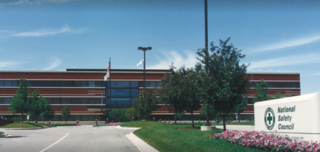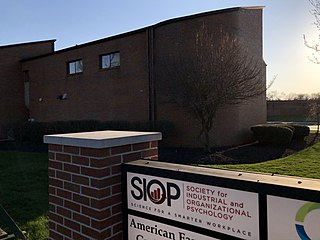
The American Institute of Architects (AIA) is a professional organization for architects in the United States. It is headquartered in located in Washington, D.C. AIA offers education, government advocacy, community redevelopment, and public outreach programs, and collaborates with other stakeholders in the design and construction industries.

The National Safety Council (NSC) is a 501(c)(3) nonprofit, public service organization promoting health and safety in the United States. Headquartered in Itasca, Illinois, NSC is a member organization, founded in 1913 and granted a congressional charter in 1953. Members include more than 55,000 businesses, labor organizations, schools, public agencies, private groups and individuals.
The American Institute of Certified Planners (AICP) is the American Planning Association's professional institute. AICP certifies professionals in the United States in the field of town planning and assists planners in the areas of ethics, professional development, planning education, and the standards of planning practice. Members of AICP pledge to adhere to a detailed Code of Ethics and Professional Conduct. Once certified, professional planners may place the designation "AICP" after their name to indicate their membership in AICP, and their mastery of the principles, skills, knowledge, and experience determined by the organization as essential for a professional planner.

Environmental planning is the process of facilitating decision making to carry out land development with the consideration given to the natural environment, social, political, economic and governance factors and provides a holistic framework to achieve sustainable outcomes. A major goal of environmental planning is to create sustainable communities, which aim to conserve and protect undeveloped land.

Planning Institute of Australia (PIA) is the peak national body representing town planning and the planning profession in Australia. PIA represents approximately 5000 members nationally and internationally. It is governed by a National Board of Directors and managed by a professional administration. It is a member-based organisation with its management complemented by volunteers, who support and contribute to its activities on various levels.

The American Institute of Graphic Arts (AIGA) is a professional organization for design. Its members practice all forms of communication design, including graphic design, typography, interaction design, user experience, branding and identity. The organization's aim is to be the standard bearer for professional ethics and practices for the design profession. There are currently over 25,000 members and 72 chapters, and more than 200 student groups around the United States. In 2005, AIGA changed its name to “AIGA, the professional association for design,” dropping the "American Institute of Graphic Arts" to welcome all design disciplines. AIGA aims to further design disciplines as professions, as well as cultural assets. As a whole, AIGA offers opportunities in exchange for creative new ideas, scholarly research, critical analysis, and education advancement.
A professional transportation planner is a professional engaged in the practice of transportation planning, relating to the transportation aspects of urban planning and infrastructure planning.

The Canadian Institute of Planners (CIP) is a professional organization in Canada for those involved in land use planning. It is responsible for advocating at national and international levels for members, developing public policy positions, and providing services to members. The Institute has over 8,000 members from across Canada and around the world, and works closely with the eleven Provincial and Territorial Institutes and Associations (PTIAs). It was founded in 1919.
The Ohio Planning Conference (OPC) is an association of citizens and planners that promotes city and regional planning in the state of Ohio. OPC is a chapter of the American Planning Association (APA) and is APA's second-oldest chapter.

The American Payroll Association (APA) is a professional association for individuals responsible for processing company payrolls. The Association conducts payroll training courses and seminars on a yearly basis and publishes a library of payroll resource texts and newsletters. APA has approximately 21,000 members, 121 APA-affiliated local chapters, and registered lobbyists based in Washington, D.C.
An urban planner is a professional who practices in the field of town planning, urban planning or city planning.
The Association for Talent Development (ATD), formerly American Society for Training & Development (ASTD), is a non-profit association serving those who develop talent in the workplace.
Israel Planners Association (IPA) (Hebrew: איגוד המתכננים בישראל, Igud HaMetakhnenim BeYisra'el) is an Israeli organization that represents all those engaged in urban and regional planning in Israel. It is a member of International Society of City and Regional Planners.

The Society for Industrial and Organizational Psychology (SIOP) is a professional organization that promotes the "science, practice, and teaching" of industrial and organizational (I/O) psychology. SIOP is also known as Division 14 of the American Psychological Association (APA). The society publishes I/O-related journals, provides its members with resources, and organizes an annual conference.
Mitchell J. Silver is the former commissioner for the New York City Parks Department. Appointed by Mayor Bill de Blasio, he assumed office May 2014, and led the department until his resignation in July 2021. He was president of the American Planning Association (APA) between 2011 and 2013, the first African American to hold the title.

The Society for the Teaching of Psychology (STP) is Division 2 of the American Psychological Association. It is an academic society that promotes effective pedagogy while providing supports for teachers of psychology at all levels. Although it is one of the divisions of the American Psychological Association, it does not require its members to join the APA. The STP provides access to peer-reviewed teaching resources, such as course syllabi and e-books, free of charge to the general public through its website. Some sections of the website require STP membership to gain access.
Indigenous planning is an ideological approach to the field of regional planning where planning is done by Indigenous peoples for Indigenous communities. Practitioners integrate traditional knowledge or cultural knowledge into the process of planning. Indigenous planning recognizes that "all human communities plan" and that Indigenous communities have been carrying out their own community planning processes for thousands of years. While the broader context of urban planning, and social planning includes the need to work cooperatively with indigenous persons and organizations, the process in doing so is dependent on social, political and cultural forces.
Margarita Piel McCoy was an American urban planner and educator. McCoy was among the first women in the United States to achieve academic tenure as a professor of urban planning, and the first to chair an urban planning department.

The Maxine Goodman Levin College of Urban Affairs (Levin) is an accredited college of urban studies, public administration, urban planning, environmental studies, and nonprofit management at Cleveland State University located in Cleveland, Ohio. The Levin College offers undergraduate, graduate, and doctoral degrees, as well as professional development programs. Its urban policy research centers and programs provide communities with decision-making tools to address their policy challenges. The Levin College is recognized for offering highly ranked programs in urban policy, local government management, nonprofit management, and public management and leadership.










